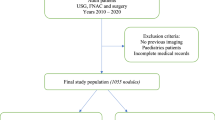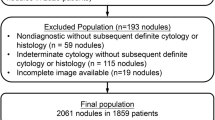Abstract
Objectives
Artificial intelligence (AI) systems can diagnose thyroid nodules with similar or better performance than radiologists. Little is known about how this performance compares with that achieved through fine needle aspiration (FNA). This study aims to compare the diagnostic yields of FNA cytopathology alone and combined with BRAFV600E mutation analysis and an AI diagnostic system.
Methods
The ultrasound images of 637 thyroid nodules were collected in three hospitals. The diagnostic efficacies of an AI diagnostic system, FNA-based cytopathology, and BRAFV600E mutation analysis were evaluated in terms of sensitivity, specificity, accuracy, and the κ coefficient with respect to the gold standard, defined by postsurgical pathology and consistent benign outcomes from two combined FNA and mutation analysis examinations performed with a half-year interval.
Results
The malignancy threshold for the AI system was selected according to the Youden index from a retrospective cohort of 346 nodules and then applied to a prospective cohort of 291 nodules. The combination of FNA cytopathology according to the Bethesda criteria and BRAFV600E mutation analysis showed no significant difference from the AI system in terms of accuracy for either cohort in our multicenter study. In addition, for 45 included indeterminate Bethesda category III and IV nodules, the accuracy, sensitivity, and specificity of the AI system were 84.44%, 95.45%, and 73.91%, respectively.
Conclusions
The AI diagnostic system showed similar diagnostic performance to FNA cytopathology combined with BRAFV600E mutation analysis. Given its advantages in terms of operability, time efficiency, non-invasiveness, and the wide availability of ultrasonography, it provides a new alternative for thyroid nodule diagnosis.
Clinical relevance statement
Thyroid ultrasonic artificial intelligence shows statistically equivalent performance for thyroid nodule diagnosis to FNA cytopathology combined with BRAFV600E mutation analysis. It can be widely applied in hospitals and clinics to assist radiologists in thyroid nodule screening and is expected to reduce the need for relatively invasive FNA biopsies.
Key Points
• In a retrospective cohort of 346 nodules, the evaluated artificial intelligence (AI) system did not significantly differ from fine needle aspiration (FNA) cytopathology alone and combined with gene mutation analysis in accuracy.
• In a prospective multicenter cohort of 291 nodules, the accuracy of the AI diagnostic system was not significantly different from that of FNA cytopathology either alone or combined with gene mutation analysis.
• For 45 indeterminate Bethesda category III and IV nodules, the AI system did not perform significantly differently from BRAFV600E mutation analysis.





Similar content being viewed by others
Abbreviations
- AI:
-
Artificial intelligence
- AUC:
-
Area under the receiver operating characteristic curve
- FNA:
-
Fine needle aspiration
- PCR:
-
Polymerase chain reaction
- PTC:
-
Papillary thyroid carcinoma
- PTMC:
-
Papillary thyroid microcarcinoma
- ROC:
-
Receiver operating characteristic
- TI-RADS:
-
Thyroid Imaging Reporting and Data Systems
References
Tessler FN, Middleton WD, Grant EG et al (2017) ACR Thyroid Imaging, Reporting and Data System (TI-RADS): white paper of the ACR TI-RADS Committee. J Am Coll Radiol 14:587–595
Cibas ES, Ali SZ (2017) The 2017 Bethesda System for Reporting Thyroid Cytopathology. Thyroid 27:1341–1346
Xing M (2019) Genetic-guided risk assessment and management of thyroid cancer. Endocrinol Metab Clin North Am 48:109–124
Li L, Li P, Chen X et al (2021) Diagnostic value of puncture feeling combined with BRAF V600E mutation in repeat US-FNA biopsy of Bethesda III thyroid nodules. Gland Surg 10:2019–2027
Rashid FA, Munkhdelger J, Fukuoka J et al (2020) Prevalence of BRAF(V600E) mutation in Asian series of papillary thyroid carcinoma-a contemporary systematic review. Gland Surg 9:1878–1900
Ellison G, Donald E, McWalter G et al (2010) A comparison of ARMS and DNA sequencing for mutation analysis in clinical biopsy samples. J Exp Clin Cancer Res 29:132
Zhang YZ, Xu T, Cui D et al (2015) Value of TIRADS, BSRTC and FNA-BRAF V600E mutation analysis in differentiating high-risk thyroid nodules. Sci Rep 5:16927
Choi YJ, Park HS, Shim WH et al (2017) A computer-aided diagnosis system using artificial intelligence for the diagnosis and characterization of thyroid nodules on ultrasound: initial clinical assessment. Thyroid 27:546–552
Li XZS, Zhang Q, Wei X et al (2019) Diagnosis of thyroid cancer using deep convolutional neural network models applied to sonographic images: a retrospective, multicohort, diagnostic study. Lancet Oncol 20:193–201
Peng S, Liu Y, Lv W et al (2021) Deep learning-based artificial intelligence model to assist thyroid nodule diagnosis and management: a multicenter diagnostic study. Lancet Digit Health 3:e250–e259
Wang Y, Xu L, Lu W et al (2023) Clinical evaluation of malignancy diagnosis of rare thyroid carcinomas by an artificial intelligent automatic diagnosis system. Endocrine 80:93–99
Guo F, Chang W, Zhao J et al (2023) Assessment of the statistical optimization strategies and clinical evaluation of an artificial intelligence-based automated diagnostic system for thyroid nodule screening. Quant Imaging Med Surg 13(2):695–706
Ma J, Wu F, Zhu J et al (2017) A pre-trained convolutional neural network based method for thyroid nodule diagnosis. Ultrasonics 73:221–230
Ma JWF, Jiang T, Zhao Q et al (2017) Ultrasound image-based thyroid nodule automatic segmentation using convolutional neural networks. Int J Comput Assist Radiol Surg 12:1895–1910
Du J, Han R, Chen C et al (2022) diagnostic efficacy of ultrasound, cytology, and BRAFV600E mutation analysis and their combined use in thyroid nodule screening for papillary thyroid microcarcinoma. Front Oncol 11:746776
Vanbelle S, Albert A (2011) A bootstrap method for comparing correlated kappa coefficients. J Stat Comput Simul 78(11):1009–1015
Fluss R, Faraggi D, Reiser B (2005) Estimation of the Youden Index and its associated cutoff point. Biom J 47:458–472
Li Y, Nakamura M, Kakudo K (2009) Targeting of the BRAF gene in papillary thyroid carcinoma (review). Oncol Rep 22(4):671–681
Han Y, Wu JQ, Hou XJ et al (2021) Strain imaging in the evaluation of thyroid nodules: the associated factors leading to misdiagnosis. Ultrasound Med Biol 47(12):3372–3383
Zatelli MC, Trasforini G, Leoni S et al (2009) BRAF V600E mutation analysis increases diagnostic accuracy for papillary thyroid carcinoma in fine-needle aspiration biopsies. Eur J Endocrinol 161(3):467–473
Grussendorf M, Ruschenburg I, Brabant G (2022) Malignancy rates in thyroid nodules: a long-term cohort study of 17,592 patients. Eur Thyroid J 11(4):e220027
Steward DL, Carty SE, Sippel RS et al (2019) Performance of a multigene genomic classifier in thyroid nodules with indeterminate cytology: a prospective blinded multicenter study. JAMA Oncol 5:204–212
Xu D, Wang Y, Wu H et al (2022) An artificial intelligence ultrasound system's ability to distinguish benign from malignant follicular-patterned lesions. Front Endocrinol (Lausanne) 13:981403
Lo W-C, Cheng P-W, Wang C-T et al (2014) Pain levels associated with ultrasound-guided fine-needle aspiration biopsy for neck masses. Head Neck 36(2):252–256
Cappelli C, Pirola I, Agosti B et al (2017) Complications after fine-needle aspiration cytology: a retrospective study of 7449 consecutive thyroid nodules. Br J Oral Maxillofac Surg 55(3):266–269
Acknowledgements
This study has a preprint which has been published in the medRxiv: https://doi.org/10.1101/2022.04.28.22274306.
Funding
This study has received funding by the Zhejiang Basic Public Welfare Research Project (LGF22H160082).
Author information
Authors and Affiliations
Corresponding authors
Ethics declarations
Guarantor
The scientific guarantor of this publication is Dingcun Luo.
Conflict of interest
This was an independent study and was not sponsored by the company that provided the AI system being evaluated. All the authors declare no conflicts of interest.
Statistics and biometry
Tianhan Zhou has significant statistical expertise.
Informed consent
Written informed consent was obtained from all subjects (patients) in this study.
Ethical approval
Institutional Review Board approval was obtained. This clinical study is registered in www.clinicaltrials.gov with the registration number of ChiCTR2200061242.
Study subjects or cohorts overlap
None study subjects or cohorts have been previously reported.
Methodology
• Retrospective
• Diagnostic study
• Multicenter study
Additional information
Publisher's note
Springer Nature remains neutral with regard to jurisdictional claims in published maps and institutional affiliations.
Supplementary information
Below is the link to the electronic supplementary material.
Rights and permissions
Springer Nature or its licensor (e.g. a society or other partner) holds exclusive rights to this article under a publishing agreement with the author(s) or other rightsholder(s); author self-archiving of the accepted manuscript version of this article is solely governed by the terms of such publishing agreement and applicable law.
About this article
Cite this article
Zhou, T., Xu, L., Shi, J. et al. US of thyroid nodules: can AI-assisted diagnostic system compete with fine needle aspiration?. Eur Radiol 34, 1324–1333 (2024). https://doi.org/10.1007/s00330-023-10132-1
Received:
Revised:
Accepted:
Published:
Issue Date:
DOI: https://doi.org/10.1007/s00330-023-10132-1




